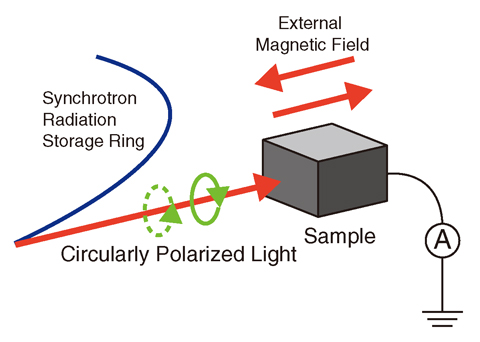
Fig.5-10 Schematic of XMCD measurements

Fig.5-11 Experimental spectra of UCoAl at the U 4d-5f (N4, 5) and Co 2p-3d (L2, 3) absorption edges

Fig.5-12 H-dependence of the XMCD intensity at the U and Co sites
Magnetism is derived from magnetic elements such as transition metal, rare-earth, and actinide elements. It is difficult to utilize actinide elements as practical devices due to radioactivity; however, actinide compounds show a variety of magnetic properties that are very attractive in the solid-state physics.
UCoAl is composed by two magnetic elements (uranium (U) and cobalt (Co)) and a nonmagnetic element (aluminum (Al)). The compound shows a metamagnetic transition (MT) from paramagnetic to ferromagnetic states at low temperature (T) when an external magnetic field (H) is applied. To understand the mechanism of the MT, grasping the magnetic behavior at the U and Co sites separately is important.
X-ray magnetic circular dichroism (XMCD) is defined as the difference in the X-ray absorption (XAS) coefficients for left and right circularly polarized light (Fig.5-10). In principle, XMCD is an element- and electronic-orbital-specific magnetic probe. In addition, the XMCD intensity is proportional to the magnitude of the magnetic moment at a target site.
Single crystals of UCoAl were grown in Advanced Science Research Center. The XMCD experiments were conducted at beamline BL23SU of SPring-8. Fig.5-11 shows XAS and XMCD spectra at the U 4d-5f (N4, 5) and Co 2p-3d (L2, 3) absorption edges. Since the peaks at the U N4 and Co L3 edges overlap each other, the magnetic information from the U and Co sites is mixed in this peak. We can separately extract the magnetic information at the U and Co sites from the peaks at 735 eV (U N5) and 795 eV (Co L2), respectively (![]() in Fig.5-11(b)).
in Fig.5-11(b)).
Fig.5-12 shows the H-dependence of the XMCD intensity at the U and Co sites measured at 5.5 K and 25 K. At 25 K, similar H-dependence is observed at the both sites (![]() ). At 5.5 K, MT is clearly observed at 0.7 T. Then, above 0.7 T, the increase ratio (slope) of the magnetic moment against H at the Co site (
). At 5.5 K, MT is clearly observed at 0.7 T. Then, above 0.7 T, the increase ratio (slope) of the magnetic moment against H at the Co site (![]() ) becomes smaller than that at the U site (
) becomes smaller than that at the U site (![]() ). In other words, the slope at the Co site shows stronger T-dependence than that at the U site. Although it has been believed until now that the magnetic properties of UCoAl are dominated by the U site, the present results suggest that the contribution of the Co site plays an important role in the magnetic behavior of this compound. The element-specific magnetic information from the XMCD experiment is valuable for understanding the mechanism of ferromagnetism in U compounds.
). In other words, the slope at the Co site shows stronger T-dependence than that at the U site. Although it has been believed until now that the magnetic properties of UCoAl are dominated by the U site, the present results suggest that the contribution of the Co site plays an important role in the magnetic behavior of this compound. The element-specific magnetic information from the XMCD experiment is valuable for understanding the mechanism of ferromagnetism in U compounds.